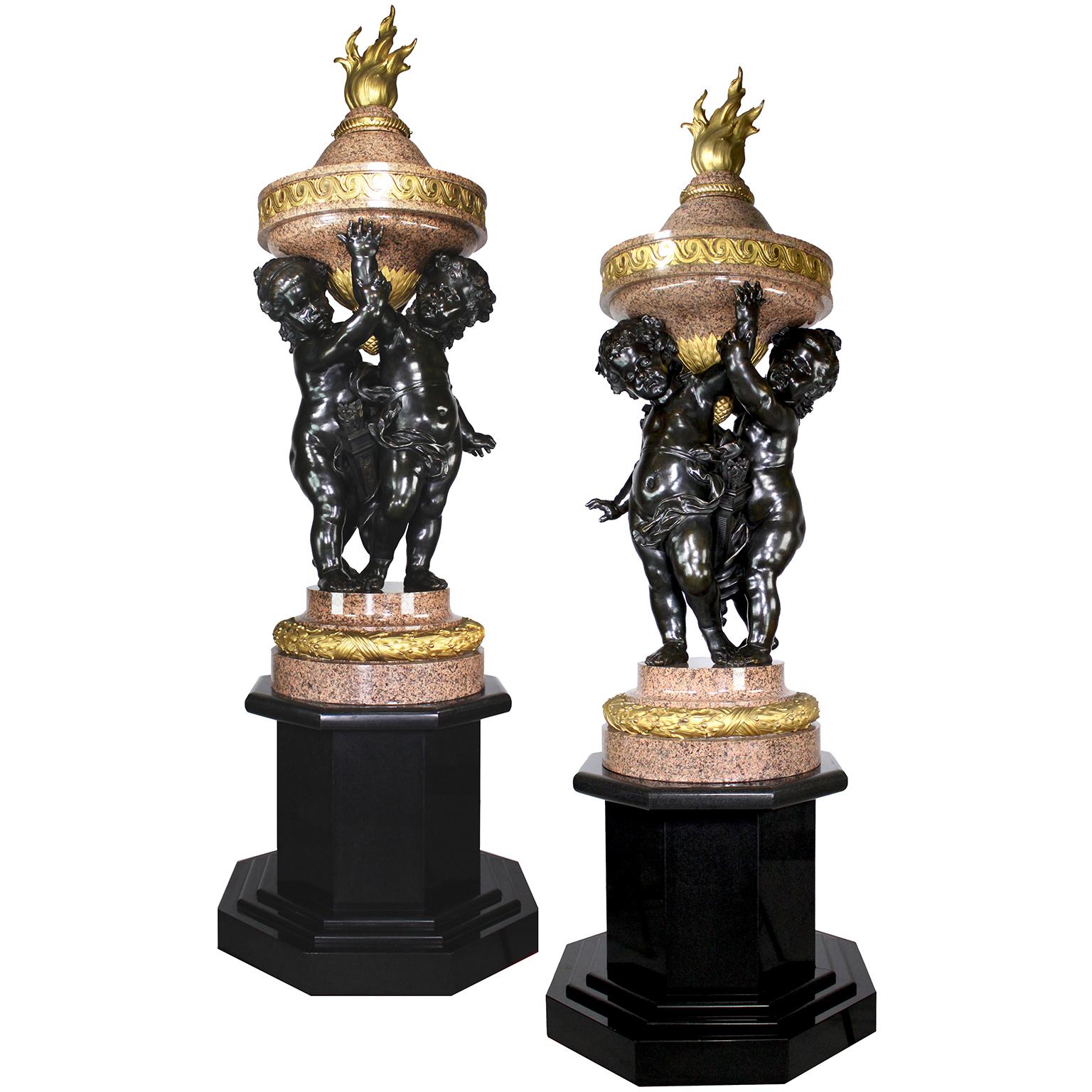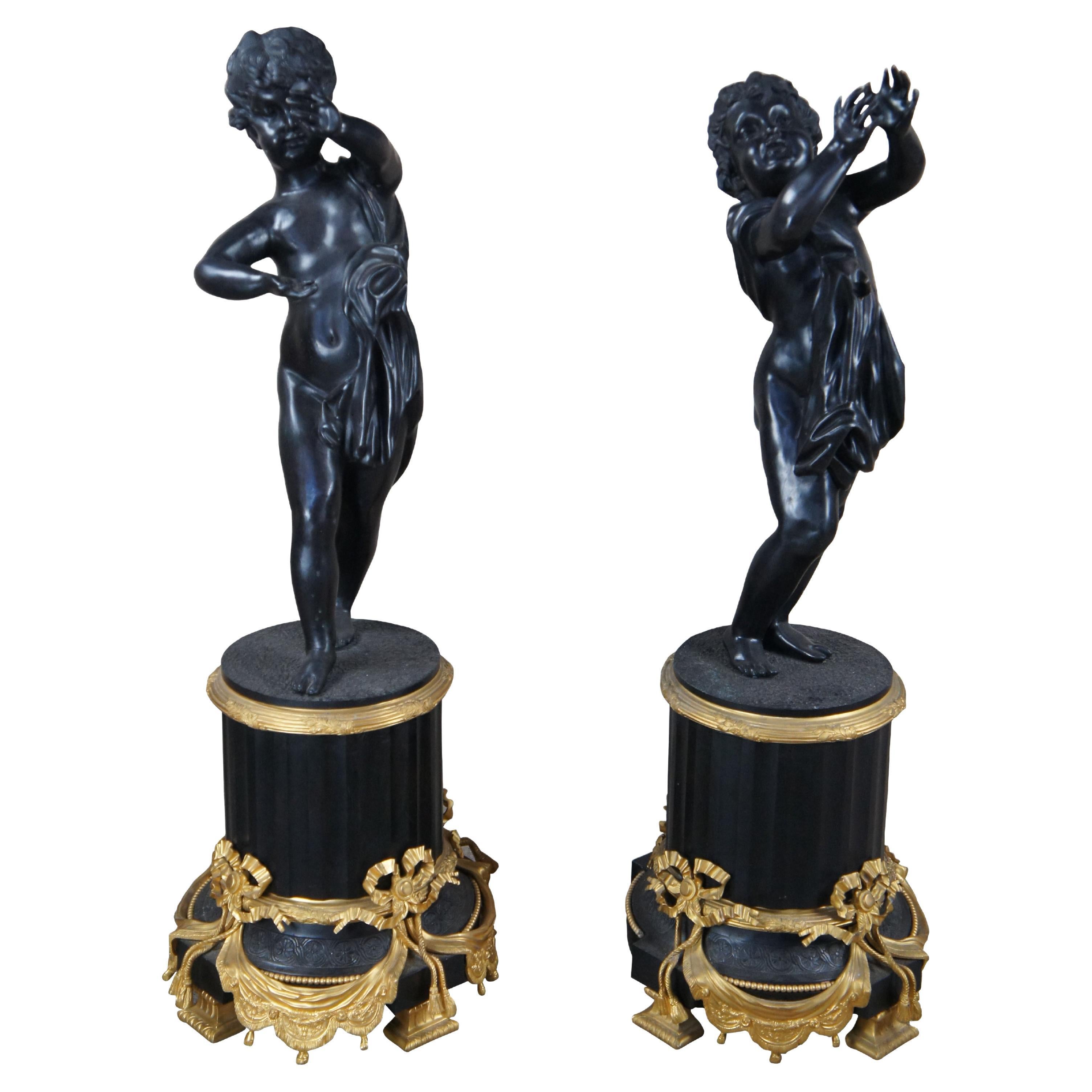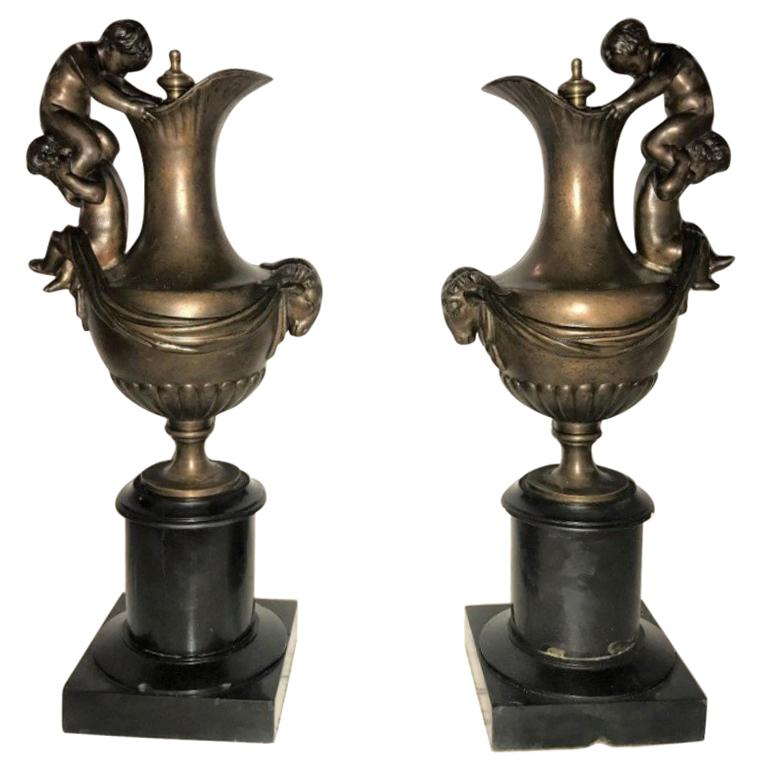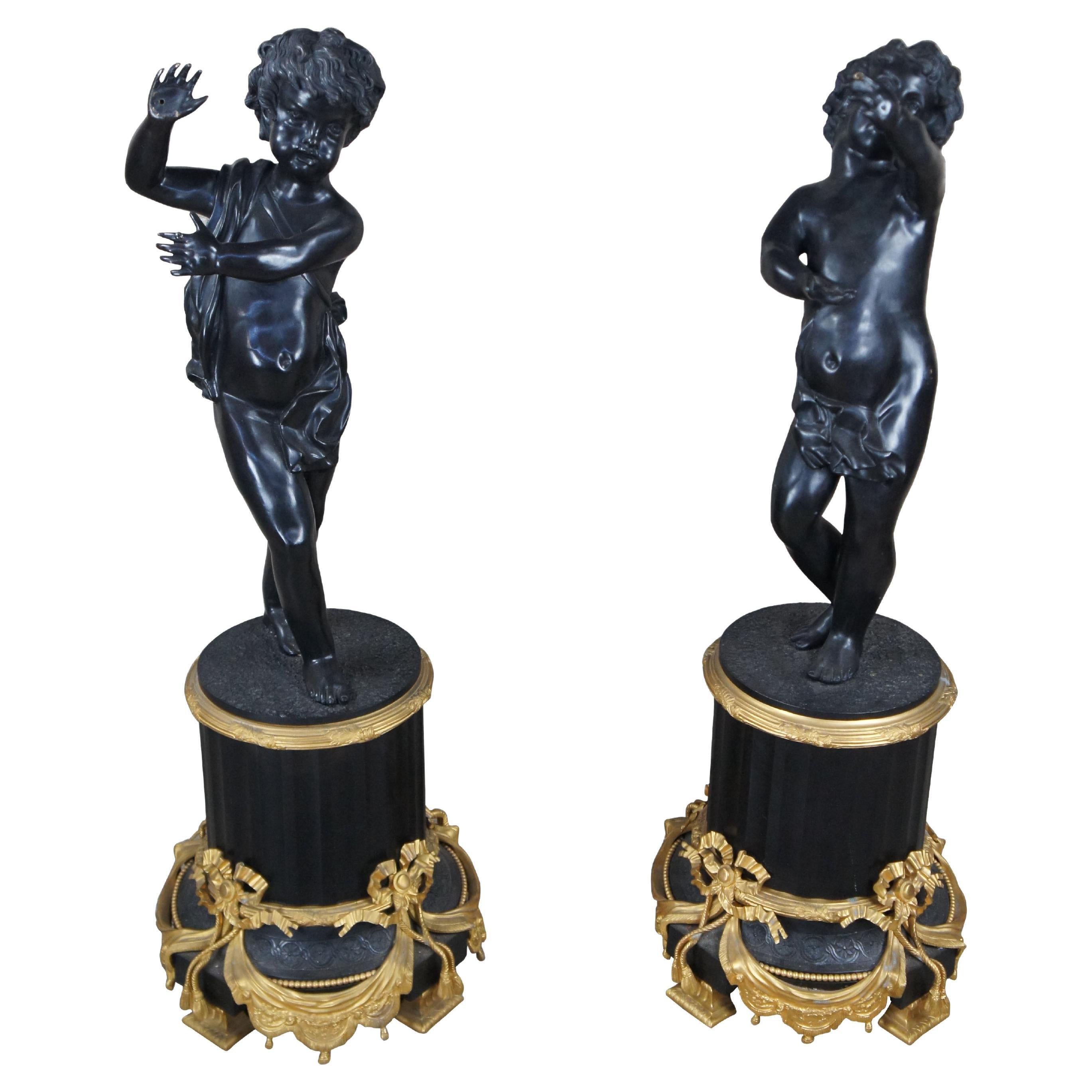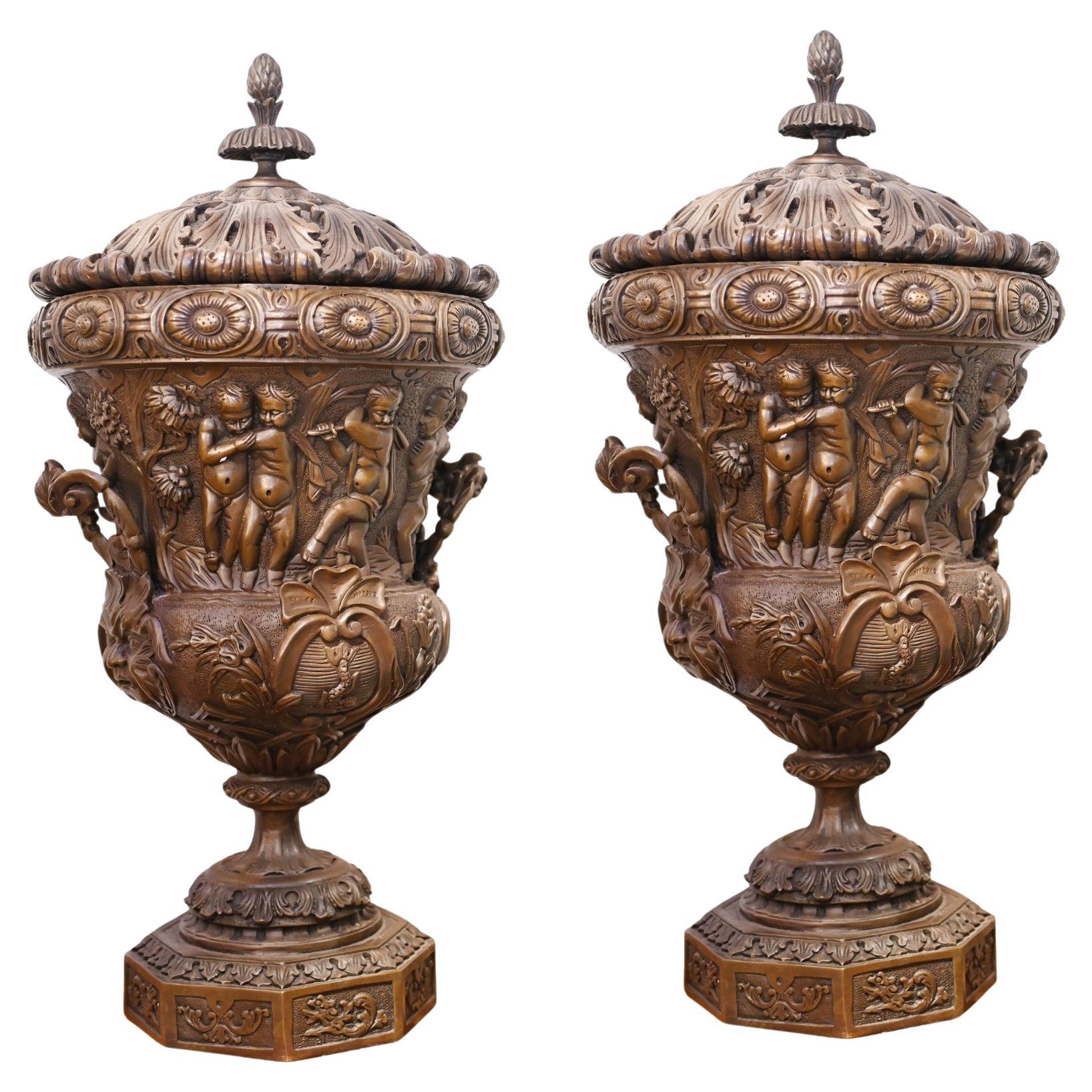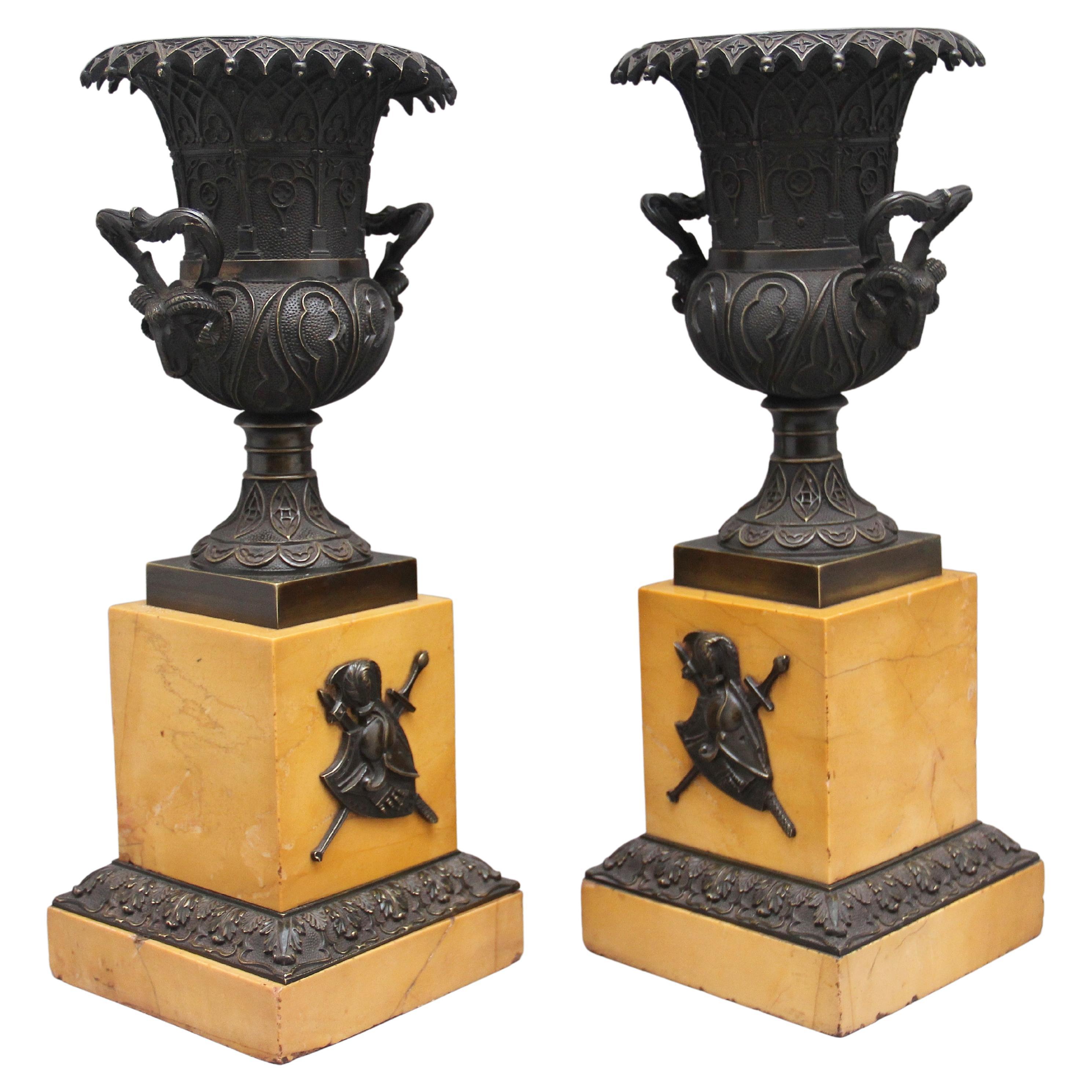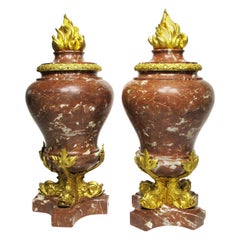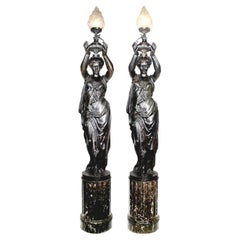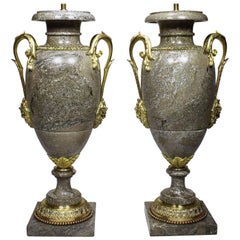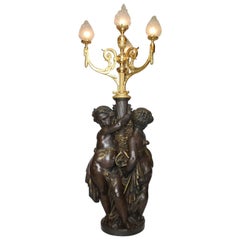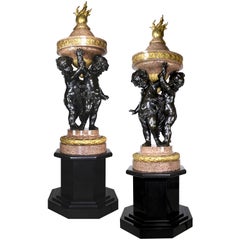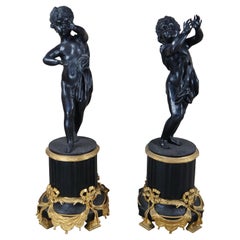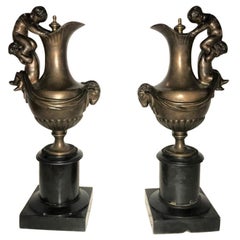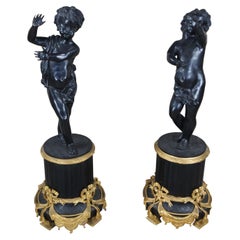Items Similar to Monumental Pair French 19th Century Putto Flambeaux Urns Torchere Urn Sculptures
Video Loading
Want more images or videos?
Request additional images or videos from the seller
1 of 22
Monumental Pair French 19th Century Putto Flambeaux Urns Torchere Urn Sculptures
$1,250,000per set
£943,950.08per set
€1,080,735.90per set
CA$1,765,326.75per set
A$1,927,314.23per set
CHF 1,010,412per set
MX$23,407,973.63per set
NOK 12,618,400.88per set
SEK 11,915,135.10per set
DKK 8,066,542.50per set
About the Item
A Monumental Museum Quality Pair of French 19th Century Figural Gilt and Patinated Bronze Rosso Granite Marble Flambeaux Urns, each depicting a pair of standing allegorical and whimsical playful children (Putti) holding a flaming urn, by René Rozet (French, 1858-1939) in the style of Claude Michel Clodion (French, 1738 - 1814) and in the manner of Alfred Emmanuel Louis Beurdeley (1847-1919). One base is signed and dated: R. Rozet, 1894, the other signed: R. Rozet. Each raised on an later octagonal black marble pedestal. Circa: Paris, 1894.
Provenance:
Sotheby's New York, Property from the Estate of Rochelle Sepenuk, Sale N8508 on 21 October 2008, Lot 144.
Sotheby's New York, 19th Centrury Furniture and Decorations, Sale N6959 on 13 March 1997, Lot 184.
The Paris-born sculptor René Rozet (1859-1939) trained with classmate Louis Majorelle at the Academie de Beaux-Arts under renowned sculptor Aimé Millet. He exhibited regularly at the Paris Salon as well as the Salon des Artistes Français, where he was awarded Hors Concours and a gold medal in 1927. He was awarded the Légion d'Honneur in 1912.
Literature: BENEZIT, E., Dictionnaire critique et documentaire des peintres, sculpteurs, dessinateurs et graveurs, tome 12, Paris, 1999, S. 63.
Claude Michel Clodion (French, 1738 - 1814) - The son-in-law of sculptor Augustin Pajou, Clodion trained in Paris in the workshops of his uncle and Jean-Baptiste Pigalle, the most successful sculptor of the time. Upon winning the Prix de Rome, he moved to Italy, sharing a studio with Jean-Antoine Houdon and studying antique, Renaissance, and Baroque sculpture. A highly skillful modeler of clay, Clodion was intensely affected by the new interest in collecting terracottas. While terracotta had been traditionally used to make sketches for larger works in more permanent and expensive materials, terracotta sculptures could now be seen as independent works of art revealing the artist's inspiration and touch. Clodion's quickly executed yet detailed terracottas were, as his earliest biographer records, "bought by amateurs even before they were finished." Among his clients, Catherine II of Russia unsuccessfully attempted to bring him to her court. In 1771 Clodion returned to Paris, where he continued to produce mostly in terracotta. He also worked with his brothers in other media, decorating objects such as candelabra, clocks, and vases. Drawing primarily from pagan antiquity, he created light-hearted terracotta sculptures that epitomized the Rococo style. Late in his life, when Neoclassial works were more popular, Clodion adjusted his style and worked on major public monuments in Paris.
Alfred Emmanuel Louis Beurdeley (1847-1919) - Specializing in reproductions of the most magnificent articles from the Garde-Meuble National, the Beurdeley firm exhibited and won awards at all of the major international exhibitions during the second half of the nineteenth century. The quality and skill employed in production was of exceptional quality; their bronze mounts with mercury gilding and hand chasing were often difficult to distinguish from late eighteenth-century examples, and were considered the finest in Paris. The firm was pioneered by Jean Beurdeley (1772-1853), later managed by his son Louis-Auguste-Alfred, and finally imparted to his son Alfred-Emmanuel-Louis in 1875. The firm was established at 32 and 34, rue Louis-Le-Grand, and also owned the pavillion de Hanovre, where it was based while Alfred-Emmanuel-Louis added two additional workshops at 20 and 24, rue Dautancourt by 1875. The Beurdeley workshops closed in 1896, although still partially active until 1898 when the stock was sold over a number of auctions conducted by the Galerie Georges Petit of Paris. Two auction catalogues of the collection were published in 1895 and sales were held between March 6-8 and May 27-28. Among Beurdeley's most prestigious clients were Emperor Napoleon III and Empress Eugénie, the duc D'aumale, Richard Wallace, the Duc and Princess d'Hamilton, Tsarine Alexandra Féodorovna, The Rothschild and Vanderbilt dynasties and the Metropolitan Club, New York.
Overall Height: 8 feet 4 1/2 inches (255.3 cm)
Torchere Height: 74 1/2 inches (189.3 cm)
Torchere Width: 23 1/2 inches (59.7 cm)
Pedestal Height: 26 inches (66 cm)
- Attributed to:René Rozet 1 (Sculptor)
- Dimensions:Height: 100.5 in (255.27 cm)Width: 36 in (91.44 cm)Depth: 36 in (91.44 cm)
- Sold As:Set of 2
- Style:Louis XV (In the Style Of)
- Materials and Techniques:
- Place of Origin:
- Period:
- Date of Manufacture:Circa: 1894
- Condition:Wear consistent with age and use. Minor fading. A truly stunning pair of torchere sculptures in great condition, some minor rubbing wear consistent with its age & use. The black marble pedestal stands are not antique. A very impressive and quite heavy sculptures requires special handling.
- Seller Location:Los Angeles, CA
- Reference Number:Seller: A12791stDibs: LU179623955573
About the Seller
5.0
Vetted Professional Seller
Every seller passes strict standards for authenticity and reliability
Established in 1982
1stDibs seller since 2016
135 sales on 1stDibs
Typical response time: <1 hour
- ShippingRetrieving quote...Shipping from: Los Angeles, CA
- Return Policy
Authenticity Guarantee
In the unlikely event there’s an issue with an item’s authenticity, contact us within 1 year for a full refund. DetailsMoney-Back Guarantee
If your item is not as described, is damaged in transit, or does not arrive, contact us within 7 days for a full refund. Details24-Hour Cancellation
You have a 24-hour grace period in which to reconsider your purchase, with no questions asked.Vetted Professional Sellers
Our world-class sellers must adhere to strict standards for service and quality, maintaining the integrity of our listings.Price-Match Guarantee
If you find that a seller listed the same item for a lower price elsewhere, we’ll match it.Trusted Global Delivery
Our best-in-class carrier network provides specialized shipping options worldwide, including custom delivery.More From This Seller
View AllFine Pair of French 19th Century Marble and Gilt Bronze-Mounted Flambeaux Urns
Located in Los Angeles, CA
A fine pair of French 19th century Rouge-Royal marble and figural gilt bronze-mounted flambeaux urns surmounted with four ormolu figures of dolphins supporting the center urn with th...
Category
Antique 19th Century French Louis XV Urns
Materials
Marble, Bronze
$19,850 Sale Price / set
43% Off
Pair of French 19th-20th Century Neoclassical Style Cast Iron Figural Torchères
Located in Los Angeles, CA
A very fine pair of French 19th-20th century neoclassical style patinated cast iron figural torchères by A. Durenne, Paris, each representing a figure of a standing young maiden, her arms raised forward while holding a a flaming urn gas light (Now electrified) with a frosted glass flame, each raised on a veined grey marble column stand, both cast-signed 'A. Durenne, Paris'. Antoine Durenne was an internationally renowned French art founder. He attended École Nationale Supérieure des Beaux-Arts in 1842. Durenne purchased a small foundry in Sommevoire, near the Val d'Osne, Haute-Marne, France and established The Durenne firm, circa Paris, 1900.
Cast-iron had been in production during the 18th century but its inferior status to the more fashionable and delicate wrought iron had generally confined its use to architectural work. By the early 19th century, however, rapid developments of the Industrial Revolution combined with the simultaneous burgeoning of a new middle class provided the impetus for a dramatic Expansion in its application and in a short space of time a proliferation of iron foundries across Europe and America thrived on the production of everything from inkstands to railway stations. The use of cast-iron for garden ornament became particularly widespread at this time, as the possibilities for its mass-production at a fraction of the cost of bronze made it the material of choice for outdoor statuary...
Category
Antique Early 1900s French Neoclassical Revival Figurative Sculptures
Materials
Marble, Iron
$49,875 Sale Price / set
41% Off
Pair of French, 19th Century Neoclassical Style Gilt Bronze and Marble Urn Lamps
Located in Los Angeles, CA
A very fine pair of French, 19th century neoclassical style gilt bronze-mounted marble urns. The ovoid form marble urns flanked by foliate scroll handles with satyr mask terminals, o...
Category
Antique Late 19th Century French Neoclassical Table Lamps
Materials
Marble, Brass, Bronze
$12,950 Sale Price / set
21% Off
French, 19th Century Versailles Style Figural Torchère with Side-by-Side Putti
By Lacarrière, Delatour and Co.
Located in Los Angeles, CA
A very fine and large Museum Quality french, 19th century Versailles Style Figural Torchère with two side-by-side Putti in a Brown and Parcel-Gilt Patina Holding a Four-Light gilt bronze Candelabrum with Frosted glass flame shades, by Lacarrière Delatour...
Category
Antique 19th Century French Louis XV Figurative Sculptures
Materials
Bronze
$49,850 Sale Price
23% Off
Pair of French 19th-20th Century Louis XV Style Gilt-Bronze Putti Table Lamps
Located in Los Angeles, CA
A fine pair of French 19th-20th century Louis XV style figural gilt bronze Putti torchere table lamps on a Rouge Royal base. Each figure representi...
Category
Antique Early 1900s French Louis XV Table Lamps
Materials
Marble, Bronze, Ormolu
Fine Pair French 19th C. Louis XV Style Gilt Bronze 6-Light Putto Candelabra Set
Located in Los Angeles, CA
A Very Fine Pair of French 19th Century Louis XV Style Gilt Bronze Figural Six-Light Candelabra. The finely chased mercury gilt ormolu pair of candelabra, each depicting a standing ...
Category
Antique Late 19th Century French Louis XV Candelabras
Materials
Bronze, Ormolu
You May Also Like
Monumental Pair French 19th Century Putto Flambeaux Urns Torchere Urn Sculptures
Located in LA, CA
A Monumental Museum Quality Pair of French 19th Century Figural Gilt and Patinated Bronze Rosso Granite Marble Flambeaux Urns, each depicting a pair of standing allegorical and whims...
Category
Late 19th Century Romantic Figurative Sculptures
Materials
Granite, Marble, Brass, Bronze
2 Italian Neoclassical Louis XV Bronze Cherub Sculptures Statues 45"
Located in Dayton, OH
Pair of Monumental Italian Neoclassical Cherub Putti Sculptures. Made from bronze with ebonized and gilt detail. Each raised over a classical fluted and footed column plinth with orn...
Category
20th Century Neoclassical Figurative Sculptures
Materials
Bronze
$4,704 Sale Price / set
20% Off
Pair of 19th Century Urns on Marble Stands Bearing Cherubs and Rams Heads
Located in Manhasset, NY
Pair of 19th century French urns on marble stands bearing cherubs and rams heads. Each of these finely chased and bronze patinated urns or water pictures were previously mounted as table lamps and can easily be converted again. The solid black pedestal column...
Category
Antique Late 19th Century French Belle Époque Figurative Sculptures
Materials
Bronze
2 Italian Neoclassical Louis XV Bronze Cherub Sculptures Statues 45"
Located in Dayton, OH
Pair of Monumental Italian Neoclassical Cherub Putti Sculptures. Made from bronze with ebonized and gilt detail. Each raised over a classical fluted and footed column plinth with or...
Category
20th Century Neoclassical Figurative Sculptures
Materials
Bronze
$4,704 Sale Price / set
20% Off
Pair Large Bronze Urns Monumental Campana Cherub after Clodion
Located in Potters Bar, GB
You are viewing an incredible pair of large bronze urns of campana form
The urns are lidded and stand in at three feet tall - 91 CM
So well cast with ...
Category
Antique 1890s Urns
Materials
Bronze
Pair of Early 19th Century Bronze Urns
Located in Martlesham, GB
A pair of French early 19th century bronze urns on marble bases, the bronze engraved urns having wonderful intricate detail including rams head handles at either side of each urn, sitting on square column marble bases decorated with a coat of arms, terminating on a marble plinth base...
Category
Antique 1820s French Abstract Sculptures
Materials
Marble, Bronze
$2,700 Sale Price / set
31% Off
More Ways To Browse
French Torchere
Monumental Urn
Bronze Torchere
Antique Marble Vases And Urns
Auction Catalogues
Pair Patinated Bronze Urns
19th Century Italian Marble Clocks
Aime Millet
Alexandra Feodorovna
Rene Rozet
Rozet Bronze
Silver Bronze Statue
Sleeping Bronze
South America Sculpture
Very Large Bronze Sculpture
Vintage Mannequin Head
17th Century Cherub
17th Century Putti
